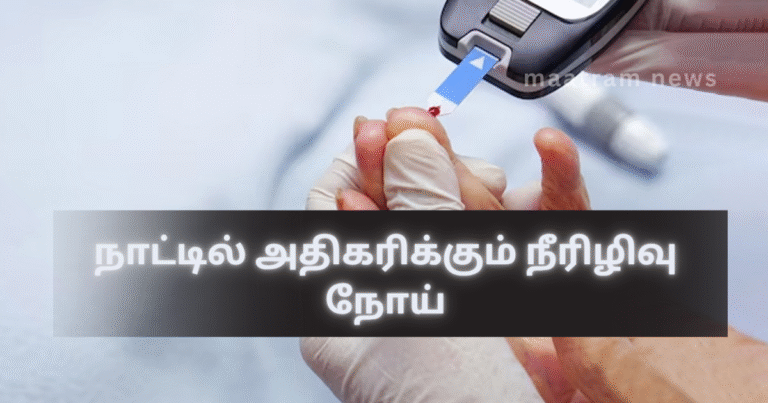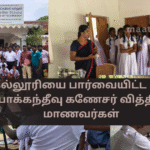நாட்டில் நீரிழிவு நோயால் பாதிக்கப்பட்டோரின் Rising Diabetes in the Country எண்ணிக்கை தொடர்ந்து அதிகரித்து வருவதால், அதன் தாக்கம் கண் ஆரோக்கியத்திலும் தீவிரமான பாதிப்புகளை ஏற்படுத்தி வருவதாக மருத்துவ நிபுணர்கள் எச்சரிக்கை விடுத்துள்ளனர். தற்போதைய கணக்கீடுகளின்படி, மக்கள் தொகையில் ஐந்து பேரில் ஒருவர் நீரிழிவு நோயால் பாதிக்கப்பட்டுள்ளார். அதிலும் கவலைக்கிடமானது, இந்த நோயால் பாதிக்கப்பட்ட மூவரில் ஒருவருக்கு குறைந்தது ஒரு வகையான கண் நோய் ஏற்படுகிறது என்பது. இதனால், நீரிழிவு நோயாளிகள் பார்வை இழப்பு அபாயத்திற்கு அதிக அளவில் உள்ளனர்.
நீரிழிவு காரணமாக உருவாகும் கண் குறைபாடுகள் பல நேரங்களில் ஆரம்பத்தில் எந்த அறிகுறிகளையும் வெளிப்படுத்தாமல் காணப்படுவதால், நோயாளிகள் அச்சிக்கலை உணராமல் இருக்கின்றனர். பரிசோதனை செய்யாமல் காலத்தை தாமதப்படுத்தினால், கண்புரை, குளுக்கோமா, ரெட்டினா சேதம் போன்ற பிரச்சினைகள் மோசமடைந்து நிரந்தர குருட்டுத்தன்மைக்குக் கூட வழிவகுக்கலாம். இதனால், தவிர்க்கக்கூடிய ஒரு நிலை சரியான நேரத்தில் மருத்துவ பரிசோதனை பெறாமல் இருப்பதால் திரும்ப முடியாத பாதிப்பாக மாறுகிறது.
மருத்துவ நிபுணர்கள் தெரிவிக்கின்றனர்: நீரிழிவு நோயாளிகள் சாதாரண மக்களை விட கண்புரை நோயால் ஐந்து மடங்கு அதிகமாக பாதிக்கப்படுகின்றனர். மேலும், நீரிழிவுக்கேற்ப கண் சார்ந்த நோய்கள் வேகமாக வளரக்கூடிய தன்மை கொண்டதால், வருடத்திற்கு குறைந்தது ஒருமுறை கண் பரிசோதனை செய்வது மிகவும் அவசியமானது. தற்போது நாட்டில் கண் நோய்களால் பாதிக்கப்பட்டு சிகிச்சை பெறாமல் உள்ளோர் எண்ணிக்கை அதிகரித்து வருவதால், இந்த பிரச்சினை தீவிர சுகாதார சவாலாக மாறி வருகிறது.
மொத்தத்தில், பார்வை இழப்பு அபாயத்தைத் தவிர்க்க நீரிழிவு நோயாளிகள் கண் பரிசோதனையை புறக்கணிக்காமல் செய்வது அவசியம் என்பதை நிபுணர்கள் வலியுறுத்துகின்றனர். அவர்களது பரிந்துரையைப் பின்பற்றுவது மட்டுமே எதிர்காலத்தில் ஏற்படக்கூடிய பார்வை சிக்கல்களைத் தடுக்கக்கூடிய மிக எளிய மற்றும் பாதுகாப்பான வழி என அவர்கள் கூறுகின்றனர்.
சுகாதார மேம்பாட்டு பணியகத்தில் நடைபெற்ற ஊடகச் சந்திப்பில் கலந்து கொண்ட கண் அறுவை சிகிச்சை நிபுணர் டாக்டர் கபில பந்துசேன, நீரிழிவு நோயாளிகளில் கண் தொடர்பான பிரச்சினைகள் எப்படி உயர்ந்து வருகின்றன எனவும், அதனால் நாட்டில் உருவாகிவரும் சுகாதார சவால்கள் குறித்து விரிவாக விளக்கினார். அவர் குறிப்பிட்டது என்னவெனில், நீரிழிவு நோய் உடலில் பல்வேறு உறுப்பு அமைப்புகளைக் பாதிப்பதோடு, கண்களின் செயல்பாட்டை நேரடியாக பாதிக்கும் தன்மை கொண்டது. குறிப்பாக, இரத்தத்தில் சர்க்கரை அளவு அதிகரிப்பதால் கண்களின் லென்ஸ், ரெட்டினா, ஆப்டிக் நரம்பு போன்ற முக்கிய பகுதிகள் சேதமடையக்கூடிய சூழல் உருவாகிறது.
அவர் எடுத்துக்காட்டிய முக்கிய அம்சங்களில் ஒன்று, நீரிழிவு நோயாளிகளில் கண்புரை (Cataract) ஏற்படும் அளவு சாதாரண மக்களை விட ஐந்து மடங்கு அதிகம் இருப்பது. கண்புரை பொதுவாக வயதானவர்களிடம் காணப்படும் ஒரு நிலையாக இருக்கும். ஆனால் நீரிழிவு நோயாளிகளில் இந்த நிலை வயதைக் கவனிக்காமல், இளம் பொது மக்களிடையே கூட விரைவாக உருவாகிறது. அதிக சர்க்கரை அளவு கண்களின் லென்ஸை மங்கச் செய்து பார்வை படிப்படியாக குறையும். இதனை பலர் ஆரம்பத்தில் சாதாரண பார்வை மங்கல் என்று நினைத்து கவனிக்காமல் விடுவதால், சிகிச்சைக்கு தாமதம் ஏற்பட்டு பின்னர் கடுமையான நிலையால் பாதிக்கப்படுகின்றனர்.
இதனோடு, குளுக்கோமா (Glaucoma) எனப்படும் மற்றொரு கண் நோயும் நீரிழிவு நோயாளர்களிடையே அதிகமாக காணப்படுவதாக டாக்டர் பந்துசேன குறிப்பிட்டார். குளுக்கோமா என்பது கண் உள்ளழுத்தம் அதிகரிப்பதால் ஆப்டிக் நரம்பு சேதமடையும் மிக ஆபத்தான கண் நோயாகும். இந்த நோய் பெரும்பாலும் ஆரம்பத்தில் எந்தவித வலி, வேதனை அல்லது தெளிவான அறிகுறிகளையும் அளிக்காது. பார்வை மையத்தில் சிறிது குறைபாடு ஏற்பட்டாலும், அதனை பலர் வயது காரணம் அல்லது விழிப்பு மூட்டம் என எண்ணி புறக்கணித்து விடுகின்றனர். குளுக்கோமா ஒருமுறை தீவிரமடைந்தால், ஆப்டிக் நரம்பு சேதத்தை மீண்டும் சரிசெய்ய முடியாது என நிபுணர்கள் எச்சரிக்கின்றனர்.
நீரிழிவு காரணமாக ஏற்படும் கண் நோய்கள் பெரும்பாலும் முன்னறிவிப்பு இல்லாமல், மெதுவாகவும் அமைதியாகவும் வளரக்கூடியவை. இது தான் இந்த பிரச்சினையின் மிக ஆபத்தான நிலைபாடாக இருப்பதாக டாக்டர் பந்துசேன வலியுறுத்துகிறார். பல நோயாளிகள் தங்களின் பார்வை குறைபாடு திடீரென ஏற்பட்டது என்று நினைத்தாலும், உண்மையில் அது பல மாதங்களாக அல்லது பல ஆண்டுகளாக கண்களில் நடைபெற்று வந்த சேதத்தின் இறுதி விளைவு ஆகும். சரியான காலத்தில் பரிசோதனை செய்திருந்தால் தடுப்பதற்கான வாய்ப்பு இருந்திருக்கும் என்று அவர் குறிப்பிட்டார்.
இந்த சூழலில், நீரிழிவு நோயாளிகள் வருடத்திற்கு குறைந்தது ஒருமுறை முழுமையான கண் பரிசோதனை செய்ய வேண்டும் என்ற பரிந்துரையை அவர் மிகத் தெளிவாக வலியுறுத்தினார். இது ஒரு சாதாரண பரிந்துரையாக அல்ல, பார்வையை காப்பாற்றும் அவசியமான மருத்துவ நடைமுறை என அவர் விளக்கினார். கண் பரிசோதனைகள் மூலம் கண்புரை, குளுக்கோமா, ரெட்டினா சேதம் போன்ற பிரச்சினைகளை ஆரம்ப கட்டத்திலேயே கண்டறிந்து, சிகிச்சையை தொடங்கினால், பெரும்பாலான நோய்களை கட்டுப்படுத்த முடியும் எனவும் அவர் தெரிவித்தார்.
நீரிழிவு நோய் வளர்ச்சியை கட்டுப்படுத்துவது மட்டுமல்லாமல், அதன் இணை நோய்கள் கண்களில் ஏற்படுத்தும் தாக்கத்தை குறைப்பதில் நோயாளிகளும் மருத்துவர்களும் விழிப்புணர்வுடன் செயல்பட வேண்டியது அவசியம் என டாக்டர் பந்துசேன தனது உரையின் முடிவில் வலியுறுத்தினார். பார்வை இழப்பு என்பது சரியான கவனத்தால் தடுக்கும் வகையில் உள்ள ஒரு நிலை என்பதால், நோயாளிகளின் பங்கு மிக முக்கியமானது என்று அவர் குறிப்பிட்டார்.
நீரிழிவு காரணமாக கண் தொடர்பான நோய்கள் அதிகரித்து வரும் இந்நேரத்தில், சிகிச்சை அமைப்புகளின் திறன் குறித்து முக்கியமான கவலைகள் எழுந்துள்ளன. கண் அறுவை சிகிச்சை நிபுணர் டாக்டர் கே.ஆர். தயாவன்ச, நாட்டின் கண் மருத்துவத் துறையில் உள்ள தொழில்நுட்ப மற்றும் உபகரணத் தட்டுப்பாடுகளை வெளிப்படையாக விளக்கினார். அவரது கூற்றுப்படி, நாட்டில் கண் அறுவை சிகிச்சைகளை மேற்கொள்ளும் தகுதி மற்றும் அறிவு வாய்ந்த நிபுணர்கள் போதுமான அளவில் இருந்தாலும், அவர்களின் திறன் முழுமையாகப் பயன்படுத்தப்படாமல் இருப்பது மிகப்பெரிய பிரச்சினையாக உருவாகியுள்ளது.
அதற்கு காரணம், அறுவை சிகிச்சை மேற்கொள்ள தேவையான அறை வசதிகள், நவீன கருவிகள் மற்றும் தொழில்நுட்ப உபகரணங்கள் குறைவாக இருப்பதுதான். குறிப்பாக, தேசிய கண் மருத்துவமனை உள்ளிட்ட பல அரசு மருத்துவமனைகளில், அறுவை சிகிச்சை அறைகள் போதுமான எண்ணிக்கையில் இல்லாததால், தினசரி திட்டமிடப்பட்ட சிகிச்சைகளைக் கூட சரியான நேரத்தில் மேற்கொள்ள முடியாமல் தாமதங்கள் ஏற்படுகின்றன. ஒரு அறை செயல்பாட்டை நிறுத்தினாலோ, அங்கு உள்ள ஒரு உபகரணம் செயலிழந்தாலோ, அனைத்து சிகிச்சை நேரங்களும் பின்னுக்குத் தள்ளப்படுவதால் நோயாளிகளின் பார்வை சிரமம் மேலும் மோசமடையும் அபாயம் உள்ளது.
மேலும் கவலைக்கிடமான விஷயமாக, மருத்துவமனைகளில் உள்ள சில உபகரணங்கள் காலாவதியானவை என்றும் டாக்டர் தயாவன்ச சுட்டிக்காட்டினார். கண் அறுவை சிகிச்சைகளில் பயன்படுத்தப்படும் மைக்ரோஸ்கோப், லேசர் கருவிகள், ரெட்டினா சிகிச்சைக்கான சிறப்பு உபகரணங்கள் போன்றவை பல ஆண்டுகளாக மாற்றமின்றி பயன்பாட்டில் இருந்து வருவதாக அவர் குறிப்பிட்டார். காலாவதியான உபகரணங்கள் சிகிச்சை தரத்தை குறைப்பதோடு மட்டுமல்லாமல், பல நேரங்களில் சிகிச்சை நேரத்தை கூட அதிகரிக்கின்றன. இதனால், ஒரு நாளில் மேற்கொள்ளக்கூடிய அறுவை சிகிச்சைகளின் எண்ணிக்கை கணிசமாக குறைகிறது.
இந்த உபகரணக் குறைபாடு நேரடியாக நோயாளிகளின் வாழ்க்கை தரத்தையே பாதிக்கும் அளவில் சென்றடைந்துள்ளது. குறிப்பாக, பார்வை குறைபாடு காரணமாக உடனடியாக சிகிச்சை தேவைப்படும் நீரிழிவு நோயாளிகள், தக்க நேரத்தில் அறுவை சிகிச்சை பெற முடியாமல் நீண்ட நாட்கள் காத்திருக்க வேண்டிய சூழல் உருவாகியுள்ளது. இதனால், காத்திருப்பு பட்டியல் தொடர்ந்து நீள்கிறது. தற்போது பல அரசு மருத்துவமனைகளில் ஆயிரக்கணக்கான நோயாளிகள் கண்புரை மற்றும் ரெட்டினா அறுவை சிகிச்சைக்காக மாதங்கள்—சில நேரங்களில் ஆண்டுகள்—காத்திருக்கும் நிலை ஏற்பட்டுள்ளது என்பதே அவர்களின் முக்கிய கவலை.
டாக்டர் தயாவன்ச கூறுகையில், நிபுணர்கள் போதுமானவர்களாக இருந்தாலும், உபகரணங்களின் தட்டுப்பாடும் அறை வசதிகளின் பற்றாக்குறையும் அவர்களின் திறமையை முழுமையாக பயன்படுத்த அனுமதிப்பதில்லை. நவீன கண் மருத்துவத் துறையில் மிகச் சிறிய தவறும் கூட பெரிய பாதிப்பை ஏற்படுத்தக்கூடியதால், உபகரணங்கள் மற்றும் தொழில்நுட்பம் எப்போதும் மேம்பட்ட நிலையில் இருக்க வேண்டும் என அவர் வலியுறுத்தினார்.
கண் நோயாளிகளின் எண்ணிக்கை அதிகரித்து வரும் நிலையில், சிகிச்சை அமைப்புகள் இந்த சுமையை தாங்கும் வகையில் உடனடி மாற்றங்கள் மற்றும் முதலீடுகள் அவசியம் என அவர் சுட்டிக்காட்டினார். துரிதமான நடவடிக்கை எடுக்கப்படாவிட்டால், எதிர்காலத்தில் பார்வை இழப்பு சம்பவங்கள் மேலும் அதிகரிக்கும் அபாயம் இருப்பதாக டாக்டர் தயாவன்ச எச்சரித்தார்.
இத்தகைய சூழலில், நீரிழிவு நோயாளிகளின் கண் ஆரோக்கியத்துக்கு அதிக கவனம் செலுத்தப்பட வேண்டியது மிக அவசியமானது என இரண்டு மருத்துவ நிபுணர்களும் வலியுறுத்துகின்றனர். நீரிழிவு காரணமாக உருவாகும் கண் நோய்கள் பல நேரங்களில் அமைதியாகவும் எச்சரிக்கை இல்லாமல் உருவாகும் தன்மை கொண்டவை என்பதால், புறக்கணிப்பும் தாமதமும் பார்வை இழப்பு வரைக்கும் இட்டுச் செல்லும் மிகப்பெரிய அபாயத்தை ஏற்படுத்துகிறது. எனவே, வருடத்திற்கு குறைந்தது ஒருமுறை கண் பரிசோதனை மேற்கொள்வது, நீரிழிவு நோயாளிகளுக்கான கட்டாய நடைமுறையாக இருக்க வேண்டும் என அவர்கள் சுட்டிக்காட்டுகின்றனர்.
அத்துடன், நாட்டின் கண் சிகிச்சை அமைப்புகளில் உள்ள உபகரண மற்றும் வசதித் தட்டுப்பாடுகள் உடனடியாக தீர்க்கப்பட வேண்டிய சுகாதார முன்னுரிமை என்பதும் குறிப்பிடத்தக்கது. காலாவதியான உபகரணங்கள் மற்றும் குறைந்த அறை வசதிகள் காரணமாக சிகிச்சை தாமதமடைவது, ஏற்கனவே அதிகரித்து வரும் நோயாளி எண்ணிக்கைக்கு கூடுதல் சுமையை ஏற்படுத்துகிறது. இந்த நிலை நீடித்தால், எதிர்காலத்தில் கண் நோயாளிகளின் காத்திருப்பு நேரம் மேலும் அதிகரிக்கும் அபாயம் உண்டு.
அதனால், நோயாளிகளும் சுகாதார நிர்வாகமும் ஒருங்கிணைந்து நடவடிக்கை எடுப்பது முக்கியம் என நிபுணர்கள் பரிந்துரைக்கின்றனர். தனிப்பட்ட முறையில், நீரிழிவு நோயாளிகள் தங்கள் கண் ஆரோக்கியத்தை முன்னுரிமையாகக் கொண்டு, காலந்தோறும் பரிசோதனை செய்து, மருத்துவ ஆலோசனைகளை தவறாமல் பின்பற்றுவது பார்வை இழப்பைத் தவிர்க்க உதவும் சிறந்த நடைமுறையாகும். நாட்டின் சுகாதார அமைப்பும் கண் சிகிச்சை துறையில் தேவையான மேம்பாடுகளைச் செய்து, அனைவருக்கும் நேர்மையான மற்றும் தரமான சிகிச்சை வழங்க வேண்டும் என அவர்கள் ஒருமித்த கருத்து தெரிவித்தனர்.
மேலதிக தகவல்களுக்கு மாற்றம் செய்திகள் இணையத்தளத்தினுள் பிரவேசியுங்கள்.
மேலதிக தகவல்களை உடனுக்குடன் பெற்றுக்கொள்ள மாற்றம் செய்திகள் முகநூல் பக்கத்தை பின்தொடரவும்.
Rising Diabetes in the Country
Due to the continuous rise in the number of people affected by diabetes in the country, medical experts have warned that its impact on eye health is becoming increasingly severe. According to current estimates, one in five people in the population is affected by diabetes. Even more concerning is the fact that one out of every three diabetic patients develops at least one type of eye disease. As a result, diabetic patients face a higher risk of vision loss.
One major challenge is that diabetes-related eye conditions often show no symptoms in the early stages, causing patients to remain unaware of the danger. If they delay medical check-ups, conditions such as cataracts, glaucoma, and retinal damage may worsen and even lead to permanent blindness. Thus, a preventable condition can become irreversible simply due to the lack of timely medical care.
Medical experts also point out that diabetic patients are five times more likely to develop cataracts compared to non-diabetics. Since diabetes-related eye diseases tend to progress rapidly, they strongly emphasize that patients should undergo at least one eye examination every year. With the number of untreated eye patients rising in the country, the issue has now become a serious public health concern.
In summary, experts stress that regular eye examinations are essential for diabetic patients to prevent the risk of vision loss. Following their recommendations is the simplest and safest way to avoid future complications.
During a media briefing at the Health Promotion Bureau, eye surgeon Dr. Kapila Bandusena explained how eye-related problems among diabetic patients are increasing and the overall health challenges this creates in the country. He noted that diabetes affects various organs in the body, and the eyes are among the most vulnerable. High blood sugar levels can damage the lens, retina and optic nerve — all of which are crucial for clear vision.
One of the key points he emphasized is that cataracts occur five times more frequently among diabetic patients than in the general population. Cataracts are usually associated with older age, but among diabetic patients, they can occur early, even in younger individuals. Excess sugar causes clouding of the eye’s lens, gradually reducing vision. Many people dismiss early signs as normal blurriness and ignore them, resulting in delayed treatment and severe complications later.
He also pointed out that glaucoma is increasingly common among diabetic patients. Glaucoma occurs when increased pressure inside the eye damages the optic nerve — a dangerous condition that often shows no initial symptoms. Even if patients experience slight vision disturbances, many mistake them for age-related problems and ignore them. Once glaucoma becomes severe, the damage to the optic nerve cannot be reversed.
The silent, gradual progression of diabetic eye diseases is what makes them most dangerous, Dr. Bandusena warned. Many patients believe their vision loss happened suddenly, but in reality, the damage may have been progressing for months or years. Early diagnosis through regular check-ups could have prevented the condition from worsening.
He strongly recommended that diabetic patients undergo a comprehensive eye examination at least once every year — not as a routine suggestion, but as a vital medical practice to protect their eyesight. Early detection and treatment of cataracts, glaucoma, and retinal problems can prevent most vision-related complications.
Dr. Bandusena concluded by saying that both patients and doctors must remain vigilant — not only in controlling diabetes itself but also in managing its impact on the eyes. Since vision loss can be prevented through proper care, patient awareness and responsibility are crucial.
Amid the rise in diabetes-related eye diseases, concerns have also grown about the capacity of the country’s eye care system. Eye surgeon Dr. K.R. Dayawansa highlighted the lack of modern equipment and facilities in the national eye care sector. Although there are enough qualified specialists, a major issue is that their expertise cannot be fully utilized due to insufficient surgical rooms and outdated medical tools.
He pointed out that even at major government hospitals, including the National Eye Hospital, the number of functional operating theatres is inadequate. If even one operating room shuts down or a vital machine becomes faulty, every scheduled surgery gets delayed. This creates serious consequences for patients already struggling with vision problems.
Dr. Dayawansa further noted that many pieces of equipment used in eye surgeries — such as microscopes, laser machines, and specialized retinal instruments — are outdated and have not been replaced for years. Outdated tools slow down procedures and reduce daily surgical capacity.
This shortage directly affects patients’ quality of life. Many diabetic patients who urgently require treatment are forced to wait months — sometimes years — for cataract or retinal surgeries. As a result, waiting lists continue to grow, with thousands currently awaiting treatment at government hospitals.
While specialists are available, their skills cannot be fully utilized without adequate equipment and facilities. Since modern eye care demands precise technology, timely upgrades are essential, he emphasized.
He warned that if immediate action is not taken, the number of vision-related complications in the future will continue to rise.
In this situation, both experts agree that greater attention must be given to the eye health of diabetic patients. Diabetes-related eye diseases often develop silently and without warning, meaning delays in treatment can lead directly to blindness. Therefore, annual eye examinations must become a mandatory practice for diabetic patients.
They also urged that the country’s eye care infrastructure requires urgent upgrades. Outdated equipment and insufficient surgical facilities are causing treatment delays at a time when the number of patients continues to increase. If this continues, waiting times will worsen.
Thus, coordinated action is needed from both patients and health authorities. For diabetic individuals, prioritizing their eye health, undergoing regular check-ups, and following medical advice is the most effective way to prevent vision loss. Meanwhile, improvements in the national eye care system are crucial to ensuring timely and quality treatment for everyone.


